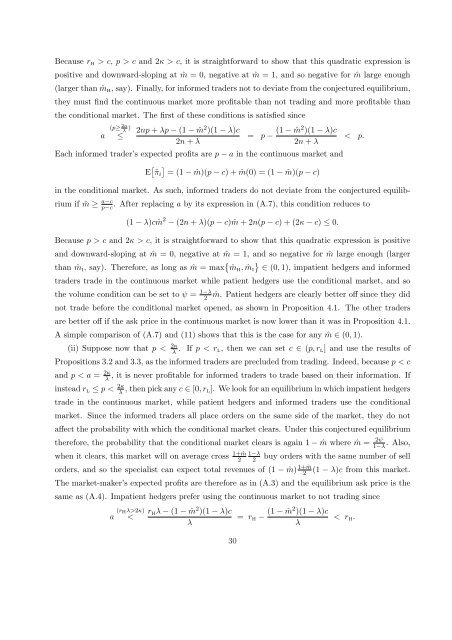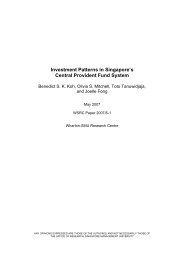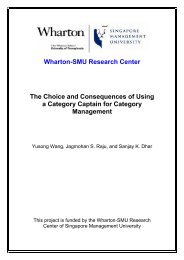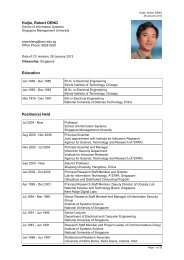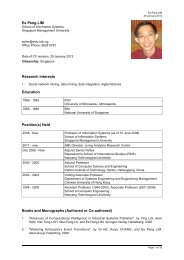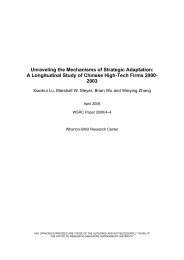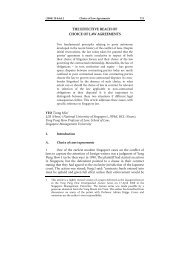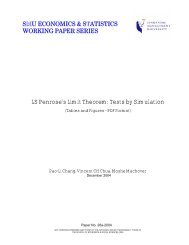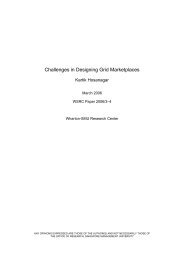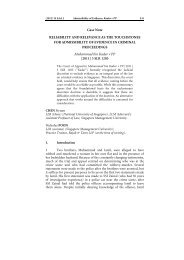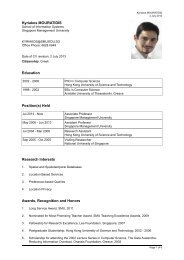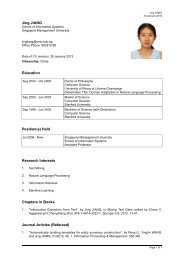The Benefits of Volume-Conditional Order-Crossing - Singapore ...
The Benefits of Volume-Conditional Order-Crossing - Singapore ...
The Benefits of Volume-Conditional Order-Crossing - Singapore ...
Create successful ePaper yourself
Turn your PDF publications into a flip-book with our unique Google optimized e-Paper software.
Because r H > c, p > c and 2κ > c, it is straightforward to show that this quadratic expression is<br />
positive and downward-sloping at ˆm = 0, negative at ˆm = 1, and so negative for ˆm large enough<br />
(larger than ˆm H, say). Finally, for informed traders not to deviate from the conjectured equilibrium,<br />
they must find the continuous market more pr<strong>of</strong>itable than not trading and more pr<strong>of</strong>itable than<br />
the conditional market. <strong>The</strong> first <strong>of</strong> these conditions is satisfied since<br />
a<br />
(p≥ 2κ<br />
λ )<br />
≤<br />
2np + λp − (1 − ˆm2 )(1 − λ)c<br />
2n + λ<br />
= p − (1 − ˆm2 )(1 − λ)c<br />
2n + λ<br />
Each informed trader’s expected pr<strong>of</strong>its are p − a in the continuous market and<br />
E <br />
˜πi = (1 − ˆm)(p − c) + ˆm(0) = (1 − ˆm)(p − c)<br />
< p.<br />
in the conditional market. As such, informed traders do not deviate from the conjectured equilib-<br />
rium if ˆm ≥ a−c<br />
p−c . After replacing a by its expression in (A.7), this condition reduces to<br />
(1 − λ)c ˆm 2 − (2n + λ)(p − c) ˆm + 2n(p − c) + (2κ − c) ≤ 0.<br />
Because p > c and 2κ > c, it is straightforward to show that this quadratic expression is positive<br />
and downward-sloping at ˆm = 0, negative at ˆm = 1, and so negative for ˆm large enough (larger<br />
than ˆm I, say). <strong>The</strong>refore, as long as ˆm = max <br />
ˆm H, ˆm I ∈ (0, 1), impatient hedgers and informed<br />
traders trade in the continuous market while patient hedgers use the conditional market, and so<br />
the volume condition can be set to ψ = 1−λ<br />
2 ˆm. Patient hedgers are clearly better <strong>of</strong>f since they did<br />
not trade before the conditional market opened, as shown in Proposition 4.1. <strong>The</strong> other traders<br />
are better <strong>of</strong>f if the ask price in the continuous market is now lower than it was in Proposition 4.1.<br />
A simple comparison <strong>of</strong> (A.7) and (11) shows that this is the case for any ˆm ∈ (0, 1).<br />
(ii) Suppose now that p < 2κ<br />
λ . If p < r L, then we can set c ∈ (p, r L] and use the results <strong>of</strong><br />
Propositions 3.2 and 3.3, as the informed traders are precluded from trading. Indeed, because p < c<br />
and p < a = 2κ<br />
λ , it is never pr<strong>of</strong>itable for informed traders to trade based on their information. If<br />
instead rL ≤ p < 2κ<br />
λ , then pick any c ∈ [0, rL]. We look for an equilibrium in which impatient hedgers<br />
trade in the continuous market, while patient hedgers and informed traders use the conditional<br />
market. Since the informed traders all place orders on the same side <strong>of</strong> the market, they do not<br />
affect the probability with which the conditional market clears. Under this conjectured equilibrium<br />
therefore, the probability that the conditional market clears is again 1 − ˆm where ˆm = 2ψ<br />
. Also,<br />
when it clears, this market will on average cross<br />
1+ ˆm 1−λ<br />
2 2<br />
1−λ<br />
buy orders with the same number <strong>of</strong> sell<br />
1+ ˆm<br />
orders, and so the specialist can expect total revenues <strong>of</strong> (1 − ˆm) 2 (1 − λ)c from this market.<br />
<strong>The</strong> market-maker’s expected pr<strong>of</strong>its are therefore as in (A.3) and the equilibrium ask price is the<br />
same as (A.4). Impatient hedgers prefer using the continuous market to not trading since<br />
a (rHλ>2κ)<br />
<<br />
r Hλ − (1 − ˆm 2 )(1 − λ)c<br />
λ<br />
30<br />
= r H − (1 − ˆm2 )(1 − λ)c<br />
λ<br />
< r H.


